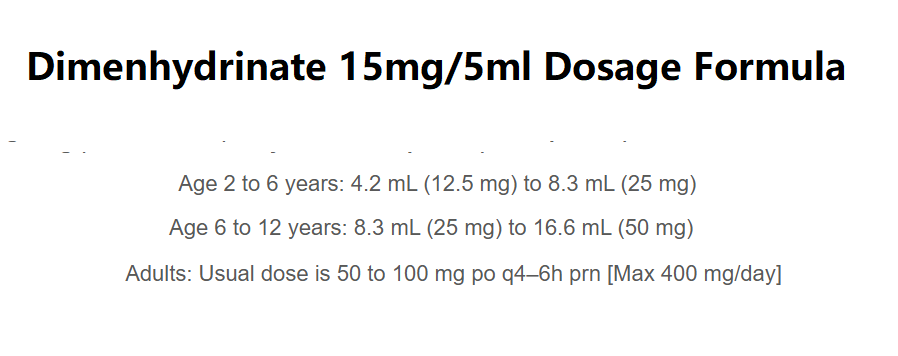 Home
Home
 Back
Back

This calculator determines the Dimenhydrinate dose for treating motion sickness or nausea, using a concentration of Dimenhydrinate 15 mg/5 mL (3 mg/mL), based on the patient’s age group:
Dose in mL and mg (based on Dimenhydrinate component):
Age 2 to 6 years: 4.2 mL (12.5 mg) to 8.3 mL (25 mg) po every 6 to 8 hours prn [Max 25 mL (75 mg) per day]
Age 6 to 12 years: 8.3 mL (25 mg) to 16.6 mL (50 mg) po every 6 to 8 hours prn [Max 50 mL (150 mg) per day]
Adults: Usual dose is 50 to 100 mg po q4–6h prn [Max 400 mg/day]
Volume Calculation:
Dose is fixed per age group, not weight-based.
Where:
Administer as needed (prn) for motion sickness or nausea symptoms, up to the maximum daily dose. ⚠️ Always consult a healthcare provider.
Select the patient’s age group. The calculator provides the dose in mL and mg for the corresponding age group.
Example: Age 2 to 6 years:
Dosage:
4.2 mL (12.5 mg) to 8.3 mL (25 mg) po every 6 to 8 hours prn [Max 25 mL (75 mg) per day]
Calculations must be re-checked and should not be used alone...
Consult a healthcare provider before administering.
Dimenhydrinate (Gravol; Dramamine; Draminate) treats motion sickness, nausea, vomiting, and vertigo.
Every 6 to 8 hours as needed (prn) for children 2–6 years (4.2–8.3 mL/12.5–25 mg, max 25 mL/75 mg per day), every 6 to 8 hours for children 6–12 years (8.3–16.6 mL/25–50 mg, max 50 mL/150 mg per day), and every 4 to 6 hours for adults (50–100 mg, max 400 mg/day).
Consult a doctor, as Dimenhydrinate is not typically recommended for children under 2 years without medical supervision.
Usual dose is 50 to 100 mg po q4–6h prn [Max 400 mg/day].